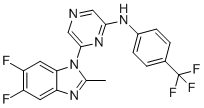PTC-028 is a potent and orally bioavailable compound that decreases BMI-1 levels by posttranslational modification. BMI-1, also known as a stem cell factor, is frequently upregulated in a number of cancers. Increased BMI-1 expression is associated with a poor prognosis, making it a promising therapeutic target in a variety of cancers, including ovarian cancer. Small-molecule inhibitors of BMI-1 are currently being developed due to its enormous pathologic significance. In clonal growth and viability assays, PTC-028 treatment preferentially inhibits cancer cells, while having no effect on normal cells. The mechanism by which PTC-028 causes the cellular BMI-1 to be depleted by hyperphosphorylation is what causes apoptosis to be caspase-dependent. This process is also accompanied by a temporal decrease in ATP and a compromised mitochondrial redox balance. In a mouse model of orthotopic ovarian cancer, PTC-028 taken orally as a single agent exhibits significant antitumor activity comparable to that of the conventional cisplatin/paclitaxel therapy. Therefore, PTC-028 has the potential to be used as an efficient therapeutic agent in patients with epithelial ovarian cancer who have few options for treatment.
Physicochemical Properties
| Molecular Formula | C19H12F5N5 | |
| Molecular Weight | 405.3241 | |
| Exact Mass | 405.101 | |
| Elemental Analysis | C, 56.30; H, 2.98; F, 23.44; N, 17.28 | |
| CAS # | 1782970-28-8 | |
| Related CAS # |
|
|
| PubChem CID | 73427235 | |
| Appearance | White to off-white solid powder | |
| LogP | 4.7 | |
| Hydrogen Bond Donor Count | 1 | |
| Hydrogen Bond Acceptor Count | 9 | |
| Rotatable Bond Count | 3 | |
| Heavy Atom Count | 29 | |
| Complexity | 556 | |
| Defined Atom Stereocenter Count | 0 | |
| InChi Key | JEZGPBWIZWPDHP-UHFFFAOYSA-N | |
| InChi Code | InChI=1S/C19H12F5N5/c1-10-26-15-6-13(20)14(21)7-16(15)29(10)18-9-25-8-17(28-18)27-12-4-2-11(3-5-12)19(22,23)24/h2-9H,1H3,(H,27,28) | |
| Chemical Name | 6-(5,6-difluoro-2-methylbenzimidazol-1-yl)-N-[4-(trifluoromethyl)phenyl]pyrazin-2-amine | |
| Synonyms |
|
|
| HS Tariff Code | 2934.99.9001 | |
| Storage |
Powder-20°C 3 years 4°C 2 years In solvent -80°C 6 months -20°C 1 month |
|
| Shipping Condition | Room temperature (This product is stable at ambient temperature for a few days during ordinary shipping and time spent in Customs) |
Biological Activity
| Targets | BMI-1 |
| ln Vitro | PTC-028 is a substance that is orally bioavailable and lowers BMI-1 levels through posttranslational modification. In clonal growth and viability assays, PTC-028 treatment selectively inhibits cancer cells, whereas normal cells are unaffected. Caspase-dependent apoptosis is enhanced by PTC-028's hyperphosphorylation-mediated depletion of cellular BMI-1, which is accompanied by a temporal decrease in ATP and a compromised mitochondrial redox balance[1]. |
| ln Vivo | In a mouse model of orthotopic ovarian cancer, PTC-028 taken orally as a single agent exhibits significant antitumor activity comparable to that of the conventional cisplatin/paclitaxel therapy. Total plasma AUC0-24h at doses of 10 mg/kg and 20 mg/kg, respectively, are 10.9 and 26.1 mg/h/mL after administration to CD-1 mice in a single oral dose, demonstrating dose-proportional pharmacokinetics. PTC-028 has a Cmax of 0.79 and 1.49 mg/mL at a dose of 10 and 20, respectively. One hour post-dose, plasma concentrations have reached their Cmax at both dose levels, and then they gradually start to decline[1]. |
| Cell Assay | PTC-028 is administered to cells for 48 hours at the indicated concentrations, and then the MTS assay is used to determine the viability of the cells. |
| Animal Protocol |
Preclinical model of ovarian cancer (NCr-nu mcie; 6 to 8 weeks old) 10 mg/kg and 20 mg/kg oral administration |
| References |
[1]. Evaluating the Mechanism and Therapeutic Potential of PTC-028, a Novel Inhibitor of BMI-1 Function in Ovarian Cancer. Mol Cancer Ther. 2018 Jan;17(1):39-49. |
Solubility Data
| Solubility (In Vitro) | DMSO: 81~125 mg/mL (199.8~308.4 mM) Ethanol: ~17 mg/mL (~41.9 mM) |
| Solubility (In Vivo) |
Solubility in Formulation 1: ≥ 2.08 mg/mL (5.13 mM) (saturation unknown) in 10% DMSO + 40% PEG300 + 5% Tween80 + 45% Saline (add these co-solvents sequentially from left to right, and one by one), clear solution. For example, if 1 mL of working solution is to be prepared, you can add 100 μL of 20.8 mg/mL clear DMSO stock solution to 400 μL PEG300 and mix evenly; then add 50 μL Tween-80 to the above solution and mix evenly; then add 450 μL normal saline to adjust the volume to 1 mL. Preparation of saline: Dissolve 0.9 g of sodium chloride in 100 mL ddH₂ O to obtain a clear solution. Solubility in Formulation 2: ≥ 2.08 mg/mL (5.13 mM) (saturation unknown) in 10% DMSO + 90% Corn Oil (add these co-solvents sequentially from left to right, and one by one), clear solution. For example, if 1 mL of working solution is to be prepared, you can add 100 μL of 20.8 mg/mL clear DMSO stock solution to 900 μL of corn oil and mix evenly. (Please use freshly prepared in vivo formulations for optimal results.) |
| Preparing Stock Solutions | 1 mg | 5 mg | 10 mg | |
| 1 mM | 2.4672 mL | 12.3359 mL | 24.6719 mL | |
| 5 mM | 0.4934 mL | 2.4672 mL | 4.9344 mL | |
| 10 mM | 0.2467 mL | 1.2336 mL | 2.4672 mL |
